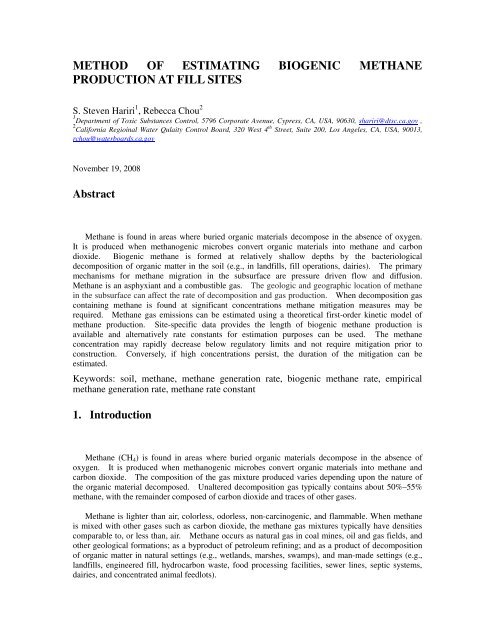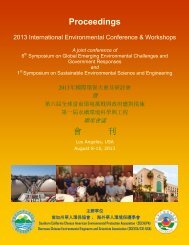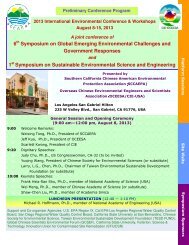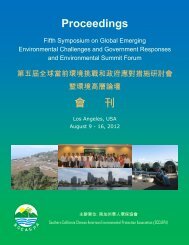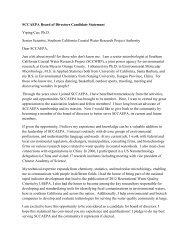method of estimating biogenic methane production at fill sites
method of estimating biogenic methane production at fill sites
method of estimating biogenic methane production at fill sites
Create successful ePaper yourself
Turn your PDF publications into a flip-book with our unique Google optimized e-Paper software.
METHOD OF ESTIMATING BIOGENIC METHANE<br />
PRODUCTION AT FILL SITES<br />
S. Steven Hariri 1 , Rebecca Chou 2<br />
1 Department <strong>of</strong> Toxic Substances Control, 5796 Corpor<strong>at</strong>e Avenue, Cypress, CA, USA, 90630, shariri@dtsc.ca.gov ,<br />
2 California Regioinal W<strong>at</strong>er Qulaity Control Board, 320 West 4 th Street, Suite 200, Los Angeles, CA, USA, 90013,<br />
rchou@w<strong>at</strong>erboards.ca.gov<br />
November 19, 2008<br />
Abstract<br />
Methane is found in areas where buried organic m<strong>at</strong>erials decompose in the absence <strong>of</strong> oxygen.<br />
It is produced when methanogenic microbes convert organic m<strong>at</strong>erials into <strong>methane</strong> and carbon<br />
dioxide. Biogenic <strong>methane</strong> is formed <strong>at</strong> rel<strong>at</strong>ively shallow depths by the bacteriological<br />
decomposition <strong>of</strong> organic m<strong>at</strong>ter in the soil (e.g., in land<strong>fill</strong>s, <strong>fill</strong> oper<strong>at</strong>ions, dairies). The primary<br />
mechanisms for <strong>methane</strong> migr<strong>at</strong>ion in the subsurface are pressure driven flow and diffusion.<br />
Methane is an asphyxiant and a combustible gas. The geologic and geographic loc<strong>at</strong>ion <strong>of</strong> <strong>methane</strong><br />
in the subsurface can affect the r<strong>at</strong>e <strong>of</strong> decomposition and gas <strong>production</strong>. When decomposition gas<br />
containing <strong>methane</strong> is found <strong>at</strong> significant concentr<strong>at</strong>ions <strong>methane</strong> mitig<strong>at</strong>ion measures may be<br />
required. Methane gas emissions can be estim<strong>at</strong>ed using a theoretical first-order kinetic model <strong>of</strong><br />
<strong>methane</strong> <strong>production</strong>. Site-specific d<strong>at</strong>a provides the length <strong>of</strong> <strong>biogenic</strong> <strong>methane</strong> <strong>production</strong> is<br />
available and altern<strong>at</strong>ively r<strong>at</strong>e constants for estim<strong>at</strong>ion purposes can be used. The <strong>methane</strong><br />
concentr<strong>at</strong>ion may rapidly decrease below regul<strong>at</strong>ory limits and not require mitig<strong>at</strong>ion prior to<br />
construction. Conversely, if high concentr<strong>at</strong>ions persist, the dur<strong>at</strong>ion <strong>of</strong> the mitig<strong>at</strong>ion can be<br />
estim<strong>at</strong>ed.<br />
Keywords: soil, <strong>methane</strong>, <strong>methane</strong> gener<strong>at</strong>ion r<strong>at</strong>e, <strong>biogenic</strong> <strong>methane</strong> r<strong>at</strong>e, empirical<br />
<strong>methane</strong> gener<strong>at</strong>ion r<strong>at</strong>e, <strong>methane</strong> r<strong>at</strong>e constant<br />
1. Introduction<br />
Methane (CH 4 ) is found in areas where buried organic m<strong>at</strong>erials decompose in the absence <strong>of</strong><br />
oxygen. It is produced when methanogenic microbes convert organic m<strong>at</strong>erials into <strong>methane</strong> and<br />
carbon dioxide. The composition <strong>of</strong> the gas mixture produced varies depending upon the n<strong>at</strong>ure <strong>of</strong><br />
the organic m<strong>at</strong>erial decomposed. Unaltered decomposition gas typically contains about 50%–55%<br />
<strong>methane</strong>, with the remainder composed <strong>of</strong> carbon dioxide and traces <strong>of</strong> other gases.<br />
Methane is lighter than air, colorless, odorless, non-carcinogenic, and flammable. When <strong>methane</strong><br />
is mixed with other gases such as carbon dioxide, the <strong>methane</strong> gas mixtures typically have densities<br />
comparable to, or less than, air. Methane occurs as n<strong>at</strong>ural gas in coal mines, oil and gas fields, and<br />
other geological form<strong>at</strong>ions; as a byproduct <strong>of</strong> petroleum refining; and as a product <strong>of</strong> decomposition<br />
<strong>of</strong> organic m<strong>at</strong>ter in n<strong>at</strong>ural settings (e.g., wetlands, marshes, swamps), and man-made settings (e.g.,<br />
land<strong>fill</strong>s, engineered <strong>fill</strong>, hydrocarbon waste, food processing facilities, sewer lines, septic systems,<br />
dairies, and concentr<strong>at</strong>ed animal feedlots).
There are two primary mechanisms by which <strong>methane</strong> is produced. These two mechanism are<br />
thermogenic and <strong>biogenic</strong>. Thermogenic <strong>methane</strong> is gener<strong>at</strong>ed <strong>at</strong> depth under elev<strong>at</strong>ed pressure<br />
during and following the form<strong>at</strong>ion <strong>of</strong> petroleum (e.g., in oil fields). Biogenic <strong>methane</strong> is formed <strong>at</strong><br />
rel<strong>at</strong>ively shallow depths by the bacteriological decomposition <strong>of</strong> organic m<strong>at</strong>ter in the soil (e.g., in<br />
land<strong>fill</strong>s, engineered <strong>fill</strong>, dairies). It is rarely found under a pressure in excess <strong>of</strong> a few inches <strong>of</strong><br />
w<strong>at</strong>er. The primary mechanisms for migr<strong>at</strong>ion in the subsurface are advection and diffusion.<br />
Methane will migr<strong>at</strong>e from areas <strong>of</strong> higher pressures or concentr<strong>at</strong>ions to areas <strong>of</strong> lower pressures or<br />
concentr<strong>at</strong>ions. Because <strong>methane</strong> is lighter than air, it has a tendency to rise from depth to the<br />
ground surface where it dissip<strong>at</strong>es into the <strong>at</strong>mosphere. Where a rel<strong>at</strong>ively impermeable barrier (e.g.,<br />
a concrete slab or geologic fe<strong>at</strong>ure) is present <strong>at</strong> the ground surface, the potential exists for<br />
accumul<strong>at</strong>ion bene<strong>at</strong>h th<strong>at</strong> barrier. Methane may infiltr<strong>at</strong>e through flooring m<strong>at</strong>erial or cracks,<br />
accumul<strong>at</strong>e under footings and in enclosed spaces (e.g., small rooms, vaults, wall spaces), and cause a<br />
fire or explosion when an ignition source (e.g., pilot flame, electrical spark, cigarette) is present.<br />
Moreover, an indic<strong>at</strong>ion <strong>of</strong> how rapidly decomposition gas is formed in the subsurface is its gas<br />
pressure. Large fluxes induce a gre<strong>at</strong>er potential for subsurface gas to migr<strong>at</strong>e into nearby buildings<br />
and other structures. If significant subsurface pressures exist over an extended period <strong>of</strong> time, then<br />
subsurface gas migr<strong>at</strong>ion by advection should be considered in addition to migr<strong>at</strong>ion by dispersion and<br />
diffusion. In addition, geological conditions can dram<strong>at</strong>ically affect the migr<strong>at</strong>ion <strong>of</strong> decomposition<br />
gas. Where soil is homogeneous with low permeability, it is less likely th<strong>at</strong> pressure gradients could<br />
drive decomposition gas long distances. However, where layers <strong>of</strong> rel<strong>at</strong>ively porous soils are<br />
covered by less porous ones, decomposition gas under pressure has the potential to move significant<br />
distances.<br />
The decomposition gas may be altered and <strong>at</strong>tenu<strong>at</strong>ed as it reaches the surface soils. The most<br />
common way th<strong>at</strong> carbon dioxide can be removed from decomposition gas is in the presence <strong>of</strong> moist<br />
or s<strong>at</strong>ur<strong>at</strong>ed soil conditions. Decomposition gas formed slowly bene<strong>at</strong>h the w<strong>at</strong>er table will lose both<br />
<strong>methane</strong> and carbon dioxide as these gases dissolve in w<strong>at</strong>er. Because carbon dioxide is about 75<br />
times more soluble than <strong>methane</strong> in w<strong>at</strong>er, much more carbon dioxide is lost. The resultant<br />
decomposition gas has rel<strong>at</strong>ively high <strong>methane</strong> and low carbon dioxide concentr<strong>at</strong>ions. The<br />
decomposition gas is also altered as it moves upward into the shallow aer<strong>at</strong>ed soil horizon. The<br />
<strong>methane</strong> component <strong>of</strong> decomposition gas is subject to dilution, oxid<strong>at</strong>ion, and microbial degrad<strong>at</strong>ion<br />
in the aer<strong>at</strong>ed zone. When the gas is moving rel<strong>at</strong>ively slowly in the uns<strong>at</strong>ur<strong>at</strong>ed soil zone, these<br />
mechanisms can significantly reduce <strong>methane</strong> concentr<strong>at</strong>ions. This may be one <strong>of</strong> the reasons th<strong>at</strong><br />
<strong>methane</strong> present <strong>at</strong> ambient pressures in the subsurface may not reach buildings constructed directly<br />
above even if no mitig<strong>at</strong>ion steps are implemented. Regul<strong>at</strong>ory limits have been set by local and<br />
st<strong>at</strong>e regul<strong>at</strong>ory agencies for investig<strong>at</strong>ion and subsequent mitig<strong>at</strong>ion <strong>of</strong> <strong>methane</strong> encountered <strong>at</strong> <strong>sites</strong>.<br />
Methane is combustible and potentially explosive when it is present <strong>at</strong> concentr<strong>at</strong>ions in excess <strong>of</strong><br />
53,000 parts per million by volume (ppmv) in the presence <strong>of</strong> oxygen. This concentr<strong>at</strong>ion is known<br />
as the lower explosive limit (LEL) <strong>of</strong> <strong>methane</strong>. Government agencies use a fraction <strong>of</strong> the LEL as an<br />
action level to trigger investig<strong>at</strong>ion and mitig<strong>at</strong>ion <strong>of</strong> encountered <strong>methane</strong>.<br />
Therefore, it is important to determine the n<strong>at</strong>ure <strong>of</strong> import soils, grading, or engineered <strong>fill</strong> <strong>at</strong> a<br />
site to evalu<strong>at</strong>e for the presence <strong>of</strong> elev<strong>at</strong>ed total organic carbon (TOC). A <strong>fill</strong> site with large<br />
amounts <strong>of</strong> plant-derived m<strong>at</strong>erials, organic topsoil, or municipal solid waste will produce rel<strong>at</strong>ively<br />
large amounts <strong>of</strong> <strong>methane</strong>, <strong>of</strong>ten over decades. The r<strong>at</strong>e <strong>of</strong> <strong>methane</strong> gener<strong>at</strong>ion will decrease over<br />
time, with the r<strong>at</strong>e <strong>of</strong> decrease determined by the n<strong>at</strong>ure <strong>of</strong> the decomposing m<strong>at</strong>erials and<br />
environmental conditions such as precipit<strong>at</strong>ion and temper<strong>at</strong>ure. Even “inert” <strong>fill</strong> soils can contain<br />
traces <strong>of</strong> roots, topsoil, and other organic m<strong>at</strong>erials. Soil <strong>fill</strong>s, deeper than 10 feet thick where<br />
anaerobic conditions may be cre<strong>at</strong>ed, can cre<strong>at</strong>e pockets <strong>of</strong> decomposition gas containing <strong>methane</strong><br />
with these small amounts <strong>of</strong> organic m<strong>at</strong>erials. To prevent <strong>methane</strong> gener<strong>at</strong>ion, a <strong>fill</strong> source with<br />
TOC <strong>of</strong> 0.5% by weight or above (DTSC, 2005) should not be used or a <strong>methane</strong> evalu<strong>at</strong>ion should be<br />
2
conducted <strong>at</strong> least 30 days after <strong>fill</strong> placement and compaction.<br />
1.1 Biological Decomposition<br />
Soil decomposition gas may be gener<strong>at</strong>ed by biological decomposition <strong>of</strong> putrescible wastes.<br />
Biological decomposition is important in most active and closed land<strong>fill</strong>s containing organic wastes,<br />
which decompose due to anaerobic microbial degrad<strong>at</strong>ion. Generally, the amount <strong>of</strong> gas gener<strong>at</strong>ed in<br />
a land<strong>fill</strong> is directly rel<strong>at</strong>ed to the amount <strong>of</strong> organic m<strong>at</strong>ter present. Waste type, in-situ<br />
characteristics, and conditions can affect biological decomposition. Under anaerobic conditions,<br />
organic wastes are primarily converted by microbial action into carbon dioxide and <strong>methane</strong>.<br />
1.2 Physical Mechanisms<br />
Several physical mechanisms describe the movement <strong>of</strong> decomposition gas through the subsurface.<br />
They are molecular diffusion and convection. Molecular diffusion occurs when there is a<br />
concentr<strong>at</strong>ion difference between two different loc<strong>at</strong>ions. Diffusive flow is in the direction <strong>of</strong><br />
decreasing concentr<strong>at</strong>ion. The density affects molecular diffusion, but the concentr<strong>at</strong>ion will tend to<br />
overcome small differences in density. In the soil <strong>at</strong>mosphere, the diffusion coefficients are only<br />
rel<strong>at</strong>ive indic<strong>at</strong>ors due to the tortuous p<strong>at</strong>h the gas must travel in the soil. Convection flow occurs<br />
when a pressure or temper<strong>at</strong>ure gradient exists between two loc<strong>at</strong>ions. Gas will flow from an area <strong>of</strong><br />
higher pressure to an area <strong>of</strong> lower pressure. Convection flow <strong>of</strong> gas will overcome the influence <strong>of</strong><br />
molecular diffusion. This type <strong>of</strong> flow is usually associ<strong>at</strong>ed with land<strong>fill</strong>s with an active extraction<br />
system. Biodegrad<strong>at</strong>ion processes, compaction effects, or <strong>methane</strong> gener<strong>at</strong>ion drives vapors<br />
vertically and horizontally. Changes in barometric pressure will have an effect on convection flow.<br />
The r<strong>at</strong>e <strong>of</strong> gas movement by convection is generally orders <strong>of</strong> magnitude gre<strong>at</strong>er than diffusion.<br />
1.3 Geologic Factors<br />
The geologic and geographic loc<strong>at</strong>ion <strong>of</strong> entry into the subsurface can affect the r<strong>at</strong>e <strong>of</strong><br />
decomposition and gas <strong>production</strong>. Soil permeability is an important factor in the movement <strong>of</strong> gas<br />
through soil. Soil permeability is the measure <strong>of</strong> the ease with which a gas or liquid can move<br />
through sediment, soil, or rock. It is rel<strong>at</strong>ed to the grain size and the amount <strong>of</strong> w<strong>at</strong>er in the soil.<br />
Soils with smaller grain sizes are less permeable. When soils contain clay size particles, soil gas<br />
movement is severely limited. Or if the soils become poorly sorted with increased fine-grained<br />
m<strong>at</strong>erial, the pore space is decreased, w<strong>at</strong>er content increases and the r<strong>at</strong>e <strong>of</strong> diffusion decreases.<br />
The most retarding layer dict<strong>at</strong>es the r<strong>at</strong>e <strong>of</strong> diffusion <strong>of</strong> gas in the vadose zone. Heterogeneous soil<br />
conditions across a site may interfere in the distribution <strong>of</strong> decomposition gas. Areas <strong>of</strong> horizontal<br />
low permeability area within the vadose zone may exhibit low concentr<strong>at</strong>ions when the level <strong>of</strong><br />
contamin<strong>at</strong>ion could be the same or higher than other areas. Conversely, high permeability areas in a<br />
low permeability area could exhibit an area <strong>of</strong> high concentr<strong>at</strong>ion. The presence <strong>of</strong> moisture in the<br />
soil decreases gas migr<strong>at</strong>ion. The soil airspace decreases as the volume <strong>of</strong> soil w<strong>at</strong>er increases,<br />
thereby inhibiting gas movement. In addition, soil moisture decreases the mass for transport by<br />
allowing the gas to partition into the pore w<strong>at</strong>er.<br />
Two geologic factors th<strong>at</strong> can lead to anomalies are barriers and conductive zones. Barriers to<br />
soil gas diffusion are obstructions, either anthropogenic or n<strong>at</strong>ural, which impede the movement <strong>of</strong><br />
decomposition gas. The obstacles can be structures, blacktop, cement, land<strong>fill</strong> caps, clay layers,<br />
perched w<strong>at</strong>er, frozen soil, irrig<strong>at</strong>ed or recently disturbed soils. The loc<strong>at</strong>ion and extent <strong>of</strong> the barrier<br />
will dict<strong>at</strong>e the direction <strong>of</strong> movement around the obstacle. Conductive zones are areas where gases<br />
3
will preferentially move because <strong>of</strong> the low resistance to movement. Conductive zones can be n<strong>at</strong>ural,<br />
such as old stream beds, gravel lenses, and fractures, or man made such as bedding around pipelines,<br />
French drains, and tunnels.<br />
1.4 Methane Gas Mitig<strong>at</strong>ion<br />
When <strong>methane</strong> decomposition gas is found <strong>at</strong> significant concentr<strong>at</strong>ions <strong>at</strong> a site above established<br />
regul<strong>at</strong>ory threshold limits, <strong>methane</strong> mitig<strong>at</strong>ion measures are required. Several basic approaches to<br />
mitig<strong>at</strong>ion are available:<br />
Excav<strong>at</strong>ion <strong>of</strong> shallow or limited <strong>methane</strong> sources<br />
Methane monitoring program<br />
Methane collection and passive vent system (without membrane)<br />
Methane collection, membrane and passive vent system<br />
Methane collection, membrane and active vent system<br />
Air injection<br />
Alarms<br />
The mitig<strong>at</strong>ion approach employed is designed to suit the particular circumstances <strong>of</strong> a site or<br />
development. Sites with large amounts <strong>of</strong> organic <strong>fill</strong> are candid<strong>at</strong>es for more involved mitig<strong>at</strong>ion<br />
systems such as active vent systems. Whereas <strong>sites</strong> with small amounts <strong>of</strong> organic <strong>fill</strong> mitig<strong>at</strong>ion<br />
may require monitoring or install<strong>at</strong>ion <strong>of</strong> a simple passive system.<br />
2. M<strong>at</strong>erials and Methods<br />
A well-established and accepted equ<strong>at</strong>ion to calcul<strong>at</strong>e <strong>methane</strong> gener<strong>at</strong>ion from putrescible m<strong>at</strong>ter<br />
is a first order differential equ<strong>at</strong>ion. The algebraic solution for this equ<strong>at</strong>ion is an exponential decay<br />
in AP 42 (USEPA, 1995) for the decomposition <strong>of</strong> refuse provides a decomposition r<strong>at</strong>e constant (k).<br />
The k ranges from an estim<strong>at</strong>ed 0.02 year -1 for areas receiving 25 inches or more <strong>of</strong> rain per year to<br />
0.04 year -1 for areas receiving less than 25 inches per year. In addition, the USEPA Land<strong>fill</strong> Gas<br />
Emissions Model (LandGem) also uses a default <strong>of</strong> 0.7 year -1 for a wet bioreactor situ<strong>at</strong>ion (Alexander<br />
et al., 1995). The primary putrescible fraction in land<strong>fill</strong>s and in typical <strong>fill</strong> soils is cellulose.<br />
However, the decomposition <strong>of</strong> cellulose is significantly higher in <strong>fill</strong> soils because <strong>of</strong> the smaller<br />
particle size <strong>of</strong> the m<strong>at</strong>erial than th<strong>at</strong> <strong>of</strong> a land<strong>fill</strong>. To evalu<strong>at</strong>e this condition, a k value <strong>of</strong> 0.15 year -1<br />
and 0.5 year -1 is considered. Such an evalu<strong>at</strong>ion does not consider the total amount <strong>of</strong> <strong>methane</strong><br />
gener<strong>at</strong>ed by the decomposition <strong>of</strong> the cellulose. It is unlikely th<strong>at</strong> the <strong>methane</strong> concentr<strong>at</strong>ion will<br />
remain as long as the model predicts using the U.S. EPA r<strong>at</strong>e constants. The r<strong>at</strong>e constants provided<br />
by the USEPA are for large land<strong>fill</strong> conditions. It is expected th<strong>at</strong> higher r<strong>at</strong>es <strong>of</strong> decay between 0.7<br />
year -1 and 1.0 year -1 are more reasonable estim<strong>at</strong>es for <strong>fill</strong> <strong>sites</strong>. Empirical r<strong>at</strong>e <strong>of</strong> decomposition has<br />
not been studied to d<strong>at</strong>e for these conditions.<br />
Therefore the uncontrolled emission <strong>of</strong> <strong>biogenic</strong> <strong>methane</strong> gener<strong>at</strong>ion may be estim<strong>at</strong>ed by using a<br />
theoretical first-order kinetic model under anaerobic conditions (USEPA, 2004). The equ<strong>at</strong>ion is as<br />
follows:<br />
C f = C o e (-kt)<br />
Where:<br />
4
C f = Final decayed <strong>methane</strong> concentr<strong>at</strong>ion in ppmV;<br />
C o = Peak <strong>methane</strong> concentr<strong>at</strong>ion in ppmV;<br />
k = R<strong>at</strong>e constant year -1 ; and<br />
t = Time in years.<br />
The uncontrolled gener<strong>at</strong>ion <strong>of</strong> the <strong>methane</strong> can be modeled based on the theoretical first-order<br />
kinetic model for a number <strong>of</strong> <strong>sites</strong> where <strong>biogenic</strong> <strong>methane</strong> is detected in <strong>fill</strong> soils. The initial<br />
<strong>methane</strong> concentr<strong>at</strong>ion is obtained by a soil gas survey during an environmental investig<strong>at</strong>ion <strong>at</strong> the<br />
site <strong>of</strong> interest. The r<strong>at</strong>e constant can be estim<strong>at</strong>ed by empirical d<strong>at</strong>a obtained for a site from ongoing<br />
long-term monitoring. Altern<strong>at</strong>ively, the r<strong>at</strong>e constants provided in the USEPA AP 42 can also be<br />
used to estim<strong>at</strong>e the length <strong>of</strong> <strong>methane</strong> <strong>production</strong>. The plot <strong>of</strong> initial concentr<strong>at</strong>ion and several<br />
estim<strong>at</strong>ed r<strong>at</strong>e constants provide an estim<strong>at</strong>ed length <strong>of</strong> <strong>methane</strong> gener<strong>at</strong>ion for a final <strong>methane</strong><br />
concentr<strong>at</strong>ion below acceptable regul<strong>at</strong>ory limits. Figure 1 shows the calcul<strong>at</strong>ed future asymptotic<br />
<strong>methane</strong> concentr<strong>at</strong>ions in soil for an initial concentr<strong>at</strong>ion <strong>of</strong> 200,000 ppmV. The initial<br />
concentr<strong>at</strong>ion chosen is reflective <strong>of</strong> initial <strong>methane</strong> concentr<strong>at</strong>ions encountered <strong>at</strong> <strong>fill</strong> <strong>sites</strong> and dairy<br />
<strong>sites</strong> throughout the Southern California area.<br />
Figure 1. Methane Concentr<strong>at</strong>ions versus time for variable degrad<strong>at</strong>ion r<strong>at</strong>es.<br />
The plot <strong>of</strong> the concentr<strong>at</strong>ion versus various r<strong>at</strong>e constants allows the estim<strong>at</strong>ion for the length <strong>of</strong><br />
time for <strong>methane</strong> mitig<strong>at</strong>ion and whether site mitig<strong>at</strong>ion is necessary. The <strong>methane</strong> concentr<strong>at</strong>ion<br />
may rapidly decrease below regul<strong>at</strong>ory limits and not require mitig<strong>at</strong>ion prior to construction.<br />
Conversely, if high concentr<strong>at</strong>ions persist, the dur<strong>at</strong>ion <strong>of</strong> the mitig<strong>at</strong>ion can be estim<strong>at</strong>ed. The<br />
estim<strong>at</strong>ion <strong>of</strong> the length <strong>of</strong> time for the anticip<strong>at</strong>ed mitig<strong>at</strong>ion system allows for cost analysis and the<br />
making <strong>of</strong> the rel<strong>at</strong>ed business decisions for current or future land development. Once a site is<br />
developed with landscaping and veget<strong>at</strong>ion, the resultant addition <strong>of</strong> irrig<strong>at</strong>ion and organic nutrients<br />
may cause <strong>methane</strong> levels to increase as it adds to the <strong>biogenic</strong> form<strong>at</strong>ion <strong>of</strong> <strong>methane</strong>. However,<br />
such a rise in the <strong>biogenic</strong> <strong>production</strong> <strong>of</strong> <strong>methane</strong> levels <strong>of</strong>f quickly, reaches a steady st<strong>at</strong>e, and the site<br />
quickly reverts back to the decreasing trends previously exhibited.<br />
5
3. Results and Discussion<br />
Based on empirical d<strong>at</strong>a from a site in Southern California, a k value between 0.7 year -1 and 10<br />
year -1 has been observed for steady st<strong>at</strong>e conditions <strong>of</strong> <strong>biogenic</strong> <strong>methane</strong> gener<strong>at</strong>ion as presented in<br />
Table 1. The average <strong>of</strong> the lowest two r<strong>at</strong>e constant values provides a k value <strong>of</strong> 1.2 year -1 whereas<br />
the average k is 4.5 year -1 . The site has been monitored for approxim<strong>at</strong>ely two and a half years to<br />
d<strong>at</strong>e. The average k value <strong>of</strong> 1.2 year -1 may be more represent<strong>at</strong>ive <strong>of</strong> steady st<strong>at</strong>e conditions in<br />
comparison with the average k <strong>of</strong> 4.5 year -1 as evidenced in its sharp decline <strong>of</strong> the <strong>methane</strong><br />
concentr<strong>at</strong>ion versus time as shown in Figure 1. Furthermore, this average k r<strong>at</strong>e results in<br />
concentr<strong>at</strong>ions th<strong>at</strong> will be asymptotic within the first year. This r<strong>at</strong>e is too aggressive for the site<br />
and therefore a k r<strong>at</strong>e <strong>of</strong> 1.0 year -1 may provide a more realistic conserv<strong>at</strong>ive estim<strong>at</strong>e for steady st<strong>at</strong>e<br />
conditions. Ultim<strong>at</strong>ely the best estim<strong>at</strong>es <strong>of</strong> the r<strong>at</strong>e constant can be g<strong>at</strong>hered by the use <strong>of</strong><br />
site-specific long-term monitoring. Due to recent <strong>at</strong>tention to <strong>biogenic</strong> <strong>methane</strong> in <strong>fill</strong> soils more<br />
<strong>sites</strong> and d<strong>at</strong>a will be available within the next few years for study. In the absence <strong>of</strong> site-specific<br />
d<strong>at</strong>a, an approxim<strong>at</strong>ion <strong>of</strong> the length <strong>of</strong> <strong>biogenic</strong> <strong>methane</strong> <strong>production</strong> is available by the referenced<br />
figure using the site’s initial <strong>methane</strong> concentr<strong>at</strong>ions.<br />
Table 1. Observed Field Empirical R<strong>at</strong>e Constants for Probes and Vents<br />
R<strong>at</strong>e Constant (year -1 )<br />
Below Ground Probes<br />
MP2-S 4.9<br />
MP-4S 0.7<br />
MP-4D 10<br />
Passice Vents<br />
A1 1.7<br />
A2 3.3<br />
A3 4.5<br />
A5 3.1<br />
A6 5.3<br />
A7 5.1<br />
B1 6.8<br />
B3 3.6<br />
B4 6.6<br />
R1 4.1<br />
R2 3.9<br />
Average 4.5<br />
4. Conclusion<br />
Methane is found in areas where buried organic m<strong>at</strong>erials decompose in the absence <strong>of</strong> oxygen.<br />
It is produced when methanogenic microbes convert organic m<strong>at</strong>erials into <strong>methane</strong> and carbon<br />
dioxide. Biogenic <strong>methane</strong> is formed <strong>at</strong> rel<strong>at</strong>ively shallow depths by the bacteriological<br />
decomposition <strong>of</strong> organic m<strong>at</strong>ter in the soil (e.g., in land<strong>fill</strong>s, <strong>fill</strong> oper<strong>at</strong>ions, dairies). The primary<br />
mechanisms for <strong>methane</strong> migr<strong>at</strong>ion in the subsurface are pressure driven flow and diffusion. Methane<br />
6
is an asphyxiant and a combustible gas. The geologic and geographic loc<strong>at</strong>ion <strong>of</strong> <strong>methane</strong> in the<br />
subsurface can affect the r<strong>at</strong>e <strong>of</strong> decomposition and gas <strong>production</strong>. When decomposition gas<br />
containing <strong>methane</strong> is found <strong>at</strong> significant concentr<strong>at</strong>ions <strong>methane</strong> mitig<strong>at</strong>ion measures may be<br />
required. Methane gas emissions can be estim<strong>at</strong>ed using a theoretical first-order kinetic model <strong>of</strong><br />
<strong>methane</strong> <strong>production</strong>. Site-specific d<strong>at</strong>a provides the length <strong>of</strong> <strong>biogenic</strong> <strong>methane</strong> <strong>production</strong> is<br />
available and altern<strong>at</strong>ively a figure with r<strong>at</strong>e constants was provided for estim<strong>at</strong>ion purposes <strong>at</strong> similar<br />
<strong>biogenic</strong> <strong>methane</strong> <strong>production</strong> <strong>fill</strong> <strong>sites</strong>. The <strong>methane</strong> concentr<strong>at</strong>ion may rapidly decrease below<br />
regul<strong>at</strong>ory limits and not require mitig<strong>at</strong>ion prior to construction. Conversely, if high concentr<strong>at</strong>ions<br />
persist, the dur<strong>at</strong>ion <strong>of</strong> the mitig<strong>at</strong>ion can be estim<strong>at</strong>ed. Based on empirical d<strong>at</strong>a from a site in<br />
Southern California, a k value <strong>of</strong> 1.0 year -1 can be used as a conserv<strong>at</strong>ive estim<strong>at</strong>e for steady st<strong>at</strong>e<br />
conditions <strong>of</strong> <strong>biogenic</strong> <strong>methane</strong> gener<strong>at</strong>ion whereas the site average k was 4.5 year -1 .<br />
5. References<br />
Alexander, A. et al., User's Manual Land<strong>fill</strong> Gas Emissions Model, Version 3.02.<br />
Research and Development, EPA-600/R-05/047. May 2005.<br />
U.S. EPA, the U.S. EPA Office <strong>of</strong><br />
California Department <strong>of</strong> Toxic Substances Control (DTSC), 2005, Advisory on Methane Assessment and Common<br />
Remedies <strong>at</strong> School Sites, d<strong>at</strong>ed June 16, 2005.<br />
USEPA (U.S. Environmental Protection Agency). 2004. Direct Emissions from Land<strong>fill</strong>ing Municipal Solid Waste.<br />
EPA430-K-04-011. October 2004.<br />
USEPA (U.S. Environmental Protection Agency). 1995. Soil screening guidance: technical background document AP<br />
42, Volume I, Fifth Edition. January 1995.<br />
7


